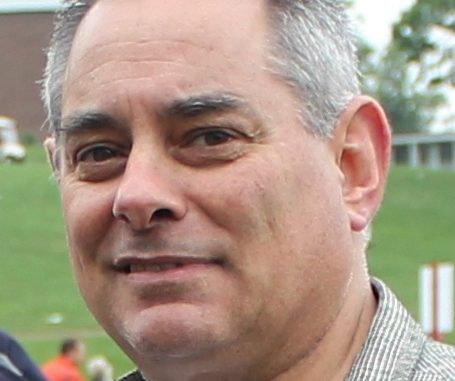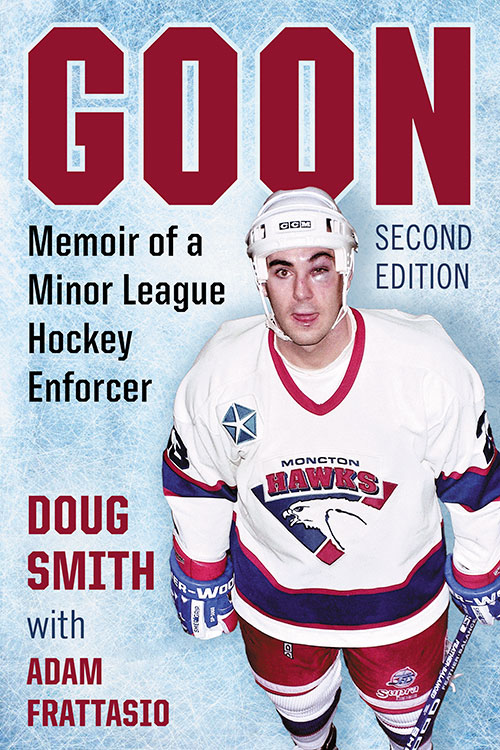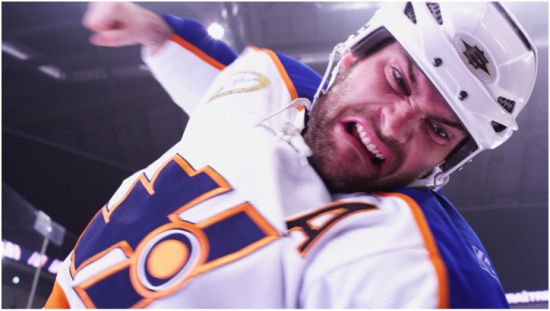
Review Fix chats with ‘Goon: The True Story of an Unlikely Journey into Minor League Hockey’ author Adam Frattasio to find out what inspired the book and why he’s proud of its legacy.

About the Book:
Goon: The True Story of an Unlikely Journey into Minor League Hockey chronicles the uniquely wild adventure of Doug Smith, who was determined to realize his dream of playing professional hockey, despite the fact he didn’t start skating until the age of 19. Armed with a burning desire and his only marketable athletic abilities – those honed as an amateur boxer – Doug defeated impossible odds to win a championship ring and play in the world’s second-best hockey league. Goon gives a raw and revealing insider’s look at the riotous world of minor league hockey and the most peculiar role in all of sport – the Goon, whose job is to protect teammates from opposing ruffians. Come along as Doug Smith, an outsider in the hockey world, literally fights his way to the highest level of minor league hockey. You may never view the game in the same light again.
About the Author:
Adam Frattasio is an adult education teacher and author of Steroid Man: Confessions of a Powerlifter from the Golden Age of Enhancement (McFarland, 2016). His first book, GOON: The True Story of an Unlikely Journey into Minor League Hockey, was adapted into the motion picture GOON and a sequel, GOON: Last of the Enforcers.
Review Fix: How did you meet Doug Smith and how was this project born?
Adam Frattasio: We grew up a bit more than a mile from each other in the nice rural town of Hanover, Massachusetts halfway between Boston and Plymouth (the Pilgrims).
I am one of nine kids, and after I went off to college one of my younger brothers started to hang around with Doug. At this point many of us were involved in a gym called the Hanover Police Boys Club, and that is where I first really came into personal contact with Doug.
Many of our crew, which included a good amount of my brothers and one sister, were jocks. We played multiple sports throughout high school and college. In fact, we have two collegiate All-Americans in my family. Anyway, Doug was attracted to our lifestyle of sports, which included the shunning of alcohol and recreational drugs. Doug liked to box, which he took up, and weight lifting, which eventually made him a hulking 6-foot-2 and 260 pounds.
On top of all the sports we participated in, which included college hockey and baseball, as well as competitive bodybuilding and powerlifting for me, our crew took a wild love of fighting in hockey. We were over the top. We had hundreds of hours of hockey fights on VHS. We watched the game strictly for the fights. We analyzed the various fighters, the reasons for the fights, the style each fighter had. We didn’t cheer for the fights in and of themselves, we actually appreciated the “art†of fighting in hockey.
To make a long story short, I introduced Doug to the “art†of hockey fights and planted a seed that with his love of boxing and hockey, there could be a place for him in the game. At the age of 19 I got him on skates, and we progressed from the local frozen ponds to weekend rented midnight rink ice to amateur adult hockey leagues just to practice fighting on ice. A friend of ours coached a team in the local Pro-Am Summer Hockey League, which local pros and college players used during the summer to stay in shape. Doug terrorized the league, got into some fights and got invited to a minor-league hockey camp with the Carolina Thunderbirds of the first-year East Coast Hockey League.
This ended with a crazy ride through the minor leagues as a goon, or hockey enforcer, and I decided to write a book about his experience.
Review Fix: What did you learn about hockey that you didn’t expect from this?

Frattasio: I really didn’t learn anything significantly new about hockey or the hockey fight world from this experience. I was already entrenched in it, up to my eyeballs. I knew as much or more about it than actual hockey fighters BEFORE Doug got involved. I even hung out with a couple of NHL hockey enforcers before I got involved with Doug. In fact, if I had been taller, I would have pursued a career as a minor-league hockey fighter.
Review Fix: What was the writing process like?
Frattasio: I don’t dare say I have a “writing process†– that would make me seem too academic.
I am a died-in-the-wool jock, which is very different from a “sports fan.†I play, hard. I am not an academic. Now, my IQ has been routinely tested out at 130 or better, so I am an intelligent person. I am knowledgeable in many different things and can hold an intelligent conversation with most people on topics ranging from world political, historical, and economic systems to how an atomic bomb works. But I am far more comfortable and fluent in the sports world. Writing process? That reads too smart for me.
My undergrad was Economics and I got an elementary teacher license and master’s in Education (Mathematics), but also nearly managed a double-major in English, especially during my desire to become a sports writer later in life. During one of those classes a professor told us to “write about what you know.†So for me, including the magazine articles I’ve written and 10 years as a sports print journalist (mostly high school sports), I wrote about what I knew – what I was comfortable with. That includes the two books I had published.
Because I am not a “trained†writer, I rest on my ability of being able to compose things where they should go. I think I’d be a good graphic designer. I think I’m good at putting a story together. Obviously, a memoir-type piece is easier because there is usually a definitive events timeline involved. So I just wrote GOON from the starting point to the end point. Not hard. The key is to write. Get stuff down and edit and rewrite later.
I will say that my initial impetus to write Doug’s story came from my oldest daughter, who was about seven at the time. She knew I liked to talk about Doug’s experiences, and that I was conversing a lot with hockey fight enthusiasts on different Internet sites and blogs. One day she just said, “Dad, you should write a book about Doug.†And damn if I didn’t listen to her and decide to do it.
Review Fix: How do you think the book has aged?
Frattasio: GOON, which was originally published in 2002, is timeless because, while fighting in hockey has been DRAMATICALLY reduced toward the point of probably being banned in the near future, the theme of the story is so humanly timeless – that of an underdog, a slacker, a guy going nowhere who harnesses the one talent he has and against daunting odds makes something of himself. That theme is why I knew, I mean I really knew GOON was going to be made into a movie. When it finally came to fruition I was excited, but never surprised. I have a son who is a talented songwriter and composer. While I will be over-the-top excited if he becomes successful with it, I certainly won’t be surprised because he is so good.
Review Fix: Why do you think it’s important today?
Frattasio: I don’t necessarily think GOON is “important†– in as much as I think other books are far more important and influential. But the theme is important, and timeless as I noted in the previous question. I think my one-sentence dedication pretty much says it all: “For all those who don’t have everything it takes, but do it anyway.†It’s a never give up, give it all you have, put your balls on the line and believe in yourself kind of thing. I think that’s a great and timeless message.
There is also another theme in GOON, one lost on most. It is the nature of what Doug did, what his role in hockey was. His role was to stand up and protect his less physical teammates. Paul Stewart, the American-born former hockey enforcer who made the US Hockey Hall of Fame later as an NHL referee, gave this answer when asked what his role was on a team he played for: “My role was the left-over one because everyone else got the English muffin. When all the good people of the town headed for the hills, I was left alone to fight the bad guy, whoever he was.â€
For me, there is something quite noble and heroic about being the guy who stands up for others, for the weaker people – the guy who is willing to put his life or physical well-being on the line to protect others from being bullied. I think it’s fucking awesome.
Review Fix: What kind of hockey do you prefer?

Frattasio: I am 57 and I prefer the style of hockey I grew up with in the 1970s, where every team had multiple tough guys who played a regular shift. These players were real characters of the game, like cartoon characters, like the characters that make mob movies like the Godfather and Goodfellas so great. They had broken noses and scars and wild hair and Fu Manchu mustaches. This evolved into a specialized role, the enforcer, in the 1980s and into the 1990s. These guys didn’t play a regular shift. They were sent out from time to time to if a message needed to be sent.
So here I am, I guy who did the youth hockey thing, was inducted into my high school’s hockey hall of fame and played a little in college, I haven’t watched a full NHL game in nearly 30 years. The players are bigger, stronger, faster, and more talented, but I’m not interested. I’ll go see a nephew or kid I know play youth, high school or college hockey, and I didn’t miss one of my daughter’s youth, high school or college hockey games, but that’s it.
Review Fix: If you could fight one player in the NHL today, who would it be and why?
Frattasio: They key word there is “today†– and that’s easy for me: Boston Bruins star forward Brad Marchand. Marchand is an incredibly talented but dirty, dishonest player who could never get away with the crap he pulls on the ice back in the day. He has many times tried to injure other players, a reason why you need tough guys. See, there must be a piper to pay for those deeds. If he pulled that crap back in the 1970s, you’d have a John Wensink or Dave Schultz or Mel Bridgeman or Steve Durbano or Nick Fotiu or Clark Gillies or Terry O’Reilly or any number of lunatics foaming at the mouth to knock the shit out of him and he would then became quite tame and well-behaved.
Review Fix: How do you think this book has affected the hockey world?
Frattasio: I wouldn’t be so bold to say that GOON affected the hockey world in, say for instance, the way it is played. But what I do know for a fact is that my book has led to many other former players, and mainly enforcers, deciding to write their own memoirs. I have had three former NHL players and one big-time minor-league goon ask me to write their stories, but I declined, mainly because I only write what I have a personal interest and love for – and I love Doug, like a brother, so I enjoyed writing his story. I would have little personal interest writing somebody’s story that I had little to no personal connection with.
And then of course there are the movies, especially the first one. GOON is the Slap Shot for the new generation of hockey players. I mean, when you hear high school and college and pro players reciting lines from the movie, it’s pretty cool.
Review Fix: How do you want it to be remembered?
Frattasio: Because of the two movies, and especially the first one, which is a cult classic, there is no choice – the book GOON has a solid and lasting connection to the game of hockey, good or bad. This means my stupid little hockey book will have more traction that a Wayne Gretzky or Mark Messier or New York Rangers book. The movie did that.
Review Fix: What’s next?
Frattasio: Since 2004 I have pretty much traded in my sports writing for a job as a high school equivalency teacher at a male-only county jail just outside Boston. While here I did pen a memoir that was published by McFarland called STEROIDMAN, which recounted my time using and selling anabolic steroids in the 1980s – the Golden Era of steroids. But ever since I started working at the jail I have been writing little stories about what I see and am told – from the inmates as well as the workers here. The stuff is gold, just incredible stories about the parallel culture that exists with people whose lives are intertwined with being locked up. It is a sub-culture that exists right along with the rest of us, and most of these people get out and are cooking your meals, repairing your roofs, delivering your new couch, collecting your tax dollars, and delivering countless fatherless children into the world. Absolutely disgusting, amazing, and comical all at once. I just can’t have it published until I retire in five years.


Leave a Reply